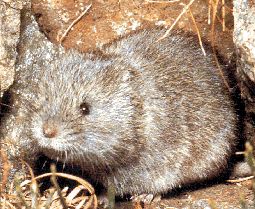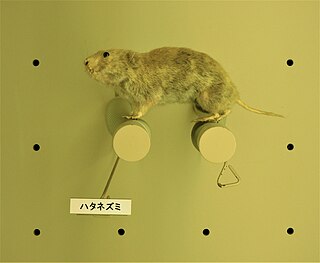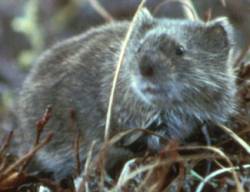
The Arvicolinae are a subfamily of rodents that includes the voles, lemmings, and muskrats. They are most closely related to the other subfamilies in the Cricetidae. Some authorities place the subfamily Arvicolinae in the family Muridae along with all other members of the superfamily Muroidea. Some refer to the subfamily as the Microtinae or rank the taxon as a full family, the Arvicolidae.

Microtus is a genus of voles found in North America, Europe and northern Asia. The genus name refers to the small ears of these animals. They are stout rodents with short ears, legs and tails. They eat green vegetation such as grasses and sedges in summer, and grains, seeds, root and bark at other times. The genus is also called "meadow voles".

Water voles are large voles in the genus Arvicola. They are found in both aquatic and dry habitat through Europe and much of northern Asia. A water vole found in Western North America was historically considered a member of this genus, but has been shown to be more closely related to members of the genus Microtus. Head and body lengths are 12–22 cm, tail lengths are 6.5–12.5 cm, and their weights are 70–250 g. The animals may exhibit indeterminate growth. They are thick-furred and have hairy fringes on their feet that improve their swimming ability.

The reed vole is a species of vole. It is found in northern and central Eurasia, including northern China and the Korean Peninsula. This species is somewhat larger and longer-tailed than most other voles.
Blanfordimys is a subgenus of voles in the family Microtus. It was formerly considered a distinct genus, but taxonomic studies group it within the Microtus radiation.

Chionomys is a genus of rodent in the family Cricetidae.
The Evorsk vole is a species of rodent in the family Cricetidae. It is found only in Russia. It is a stout rodent with short ears, legs and tails. This species lives in grassy areas where it eats green vegetation such as grasses and sedges in summer, and grains, seeds, roots and bark at other times.
Gerbe's vole or the Pyrenean pine vole ) is a species of rodent in the family Cricetidae found in France and Spain.

The lacustrine vole is a species of rodent in the family Cricetidae. It is found in China and Mongolia.
Maximowicz's vole is a species of rodent in the family Cricetidae. It is found in northeastern China, Mongolia, and eastern Russia.
Middendorff's vole is a species of rodent in the family Cricetidae. It is found only in Russia, most commonly north Siberia.
The Mongolian vole is a species of rodent in the family Cricetidae. It is found in China, Mongolia, and Russia.

The Japanese grass vole is a species of rodent in the family Cricetidae. It is found only in Japan.
The Muya Valley vole or Muisk vole is a species of rodent in the family Cricetidae. It is found only in Russia.
The Sakhalin vole is a species of rodent in the family Cricetidae. It is found only in Russia.
The Duke of Bedford's vole is a species of rodent in the family Cricetidae. After the Liangshan vole was removed from this genus, the Duke of Bedford's vole became the only member of the genus Proedromys. It is found only in mountainous parts of central China. It is a rare species and the International Union for Conservation of Nature has assessed its conservation status as being "vulnerable".

Alexandromys is a genus of voles in the subfamily Arvicolinae, formerly a subgenus of the genus Microtus. Species in this genus are:
The Liangshan vole is a species of rodent in the family Cricetidae. It used to be placed in Proedromys, but has been moved to Mictomicrotus, where it is the sole member of its genus. It is found only in mountainous parts of central China.
The Kerman vole or Baluchistan vole is a species of vole. It is found in Kerman Province, Iran.

Microtini is a tribe of voles in the subfamily Arvicolinae.









